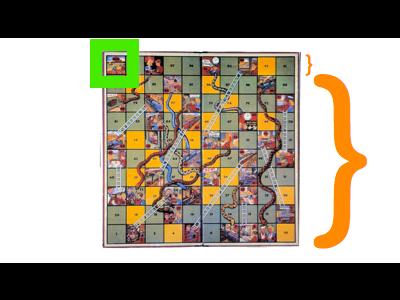
Now attention is partially voluntary, but partially it’s automatic too. Imagine every object in this room is sitting on this snakes and ladders board – I was pleased to see a snakes and ladders project in the conference pack, by the way – and the objects are moving around. Your brain has this game board, and it using it to allocate attention.
Everything down here (bottom rows) are just things in the room. You’re generally unaware of what they’re doing, and short of a loud noise or flashing light, you don’t notice what they do.
On this top row, there are the few things you have partial awareness of. You’ll notice the person ahead of you move, perhaps, or – if I mention it – the background hum in the room.
Right at the final square is what you’ve got focus on. This is what you’re actually conscious of. You notice every little change.
Now, you can choose to put objects in the room at different places on the board.
But sometimes, if objects do the right things, they move on their own. If there’s a sudden movement in the corner of your eye, up a ladder it goes! If something fades or gets smaller, it goes down a snake. You can’t help but forget things which go out of view, or focus on that door opening at the front of the cinema when you’re trying to watch the film.
Naturally, it’s harder for things at the bottom to push up… but it’s good for us to know what the big snakes and ladders are, because then we know how people perceive the world, and then we know how to put the rules into designs so they’re instantly appreciated rather than having to be deduced.
direction.)